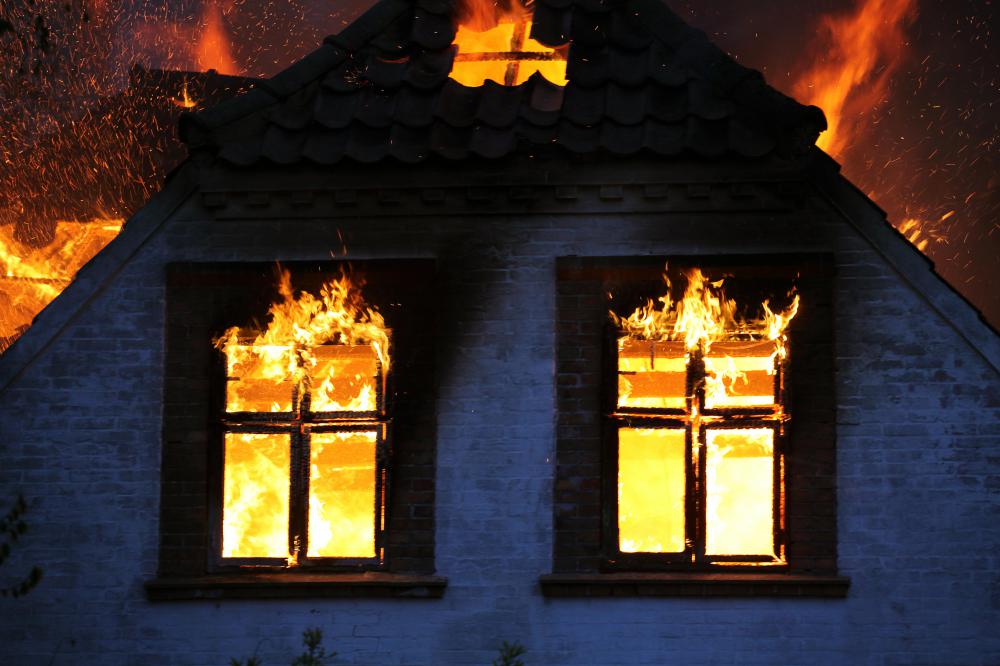At HomeQuestionsAnswered, we're committed to delivering accurate, trustworthy information. Our expert-authored content is rigorously fact-checked and sourced from credible authorities. Discover how we uphold the highest standards in providing you with reliable knowledge.
How do I Prevent a Chimney Fire?
A chimney fire might seem like an unlikely event, as most chimneys are well insulated and seem very removed from the rest of the house. In fact, a chimney fire can catch quite easily, often with little or no warning, and at its worst can burn down an entire house. With just a little bit of work, however, a chimney fire can be prevented, protecting your house and the surrounding area.
It’s helpful to understand exactly what causes a chimney fire, so you can better understand how to prevent it. When wood burns, it creates smoke, which goes up the chimney and leaves the house into the surrounding air. But while smoke is gaseous, it often does not remain that way for very long, as it cools quickly and condenses to the inside of the chimney. As it condenses, the particles in the smoke bond together to form a flaky or gummy substance on the inside of the chimney. It is this substance, creosote, which causes a chimney fire.

Creosote can be quite flammable, and all it takes is a single spark in the wrong conditions to start a chimney fire. Especially during high-wind situations where an updraft is formed, sparks can be pulled up through the chimney, and if they ignite the creosote, it can be very difficult to put out the resulting fire. It is in keeping creosote levels low that chimney fires are avoided, and thankfully it is relatively easy to keep the inside of your chimney clean.

Unseasoned, or green, wood is the main cause of creosote buildup, so the easiest way to reduce the chances of a chimney fire is to use well-cured wood. Green wood burns much cooler than seasoned wood, and as a result the smoke is more likely to condense on the inside of the chimney and cause creosote buildup. If you buy wood, always make sure to buy seasoned firewood, even if green wood is a bit cheaper. If you cut your own wood, make sure to do so with plenty of time to let it properly season before you need to use it.
Creating the hottest fires you can is another good way to reduce creosote buildup, and therefore the chances of a chimney fire. Building large, slow-catching and slow-burning fires will create cooler smoke, which is more likely to condense. By keeping fires small and hot, you increase the chances that the smoke will remain in a gaseous form until it has left your chimney.
Some level of creosote buildup is inevitable, and there are two huge things you can do to further reduce the risk of a chimney fire. The first is to never burn anything that can easily catch on fire and then be pulled up the chimney on a hot air current while on fire. Tissues and wrapping paper are two good examples of dangerous items to put in the fireplace, as they can act as an easy transport vehicle for the flame into the chimney. The second, and perhaps most important step you can take is to have your chimney regularly cleaned by a chimney sweep, especially before the winter season. A professional chimney sweep can remove virtually all of the creosote buildup in your chimney, and can give you added pointers on how to keep your chimney clean.
AS FEATURED ON:
AS FEATURED ON:












Discussion Comments
Sporkasia - Do you really think most people have their chimneys cleaned that often (once a year)? I would be surprised if they do. I'm not saying chimneys shouldn't be cleaned once a year, but I doubt most people have it done that often.
In between cleanings, we use creosote cleaning logs that can be bought at many stores. You just start a fire and once the fire has burned for about 30 minutes you place a creosote cleaning log onto the fire and let it do its job.
The log burns and cleans the deposits in the chimney. I can't say for certain how much this helps, but we feel better knowing that we are doing something between cleanings.
Drentel - A chimney should be cleaned once a year by a professional chimney sweep to make sure there is no creosote build up that might start a fire.
How often should a chimney be cleaned to prevent a creosote chimney fire?
Drentel - When you keep a brick chimney clean, there is no greater risk of fire than there is with other methods of heating, such as a boiler, gas furnace or whatever. The problem is many people who burn wood don't have the chimneys cleaned regularly. This increases the risk of fire significantly.
As a teenager, I would help my father cut firewood on Saturdays. The wood went straight from the tree and into the fireplace--no seasoning. We had no idea, or at least I had no idea, that cutting the wood and allowing it to dry out for several months would have been much safer.
Fortunately, we never had a chimney fire, but that would have been a good bit of information to have. I wonder how many fires are caused by chimneys. It would be interesting to see some chimney fire statistics.
Post your comments